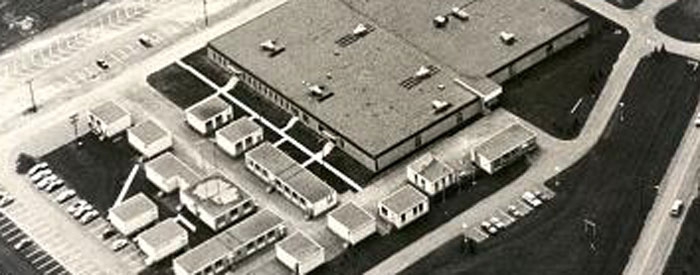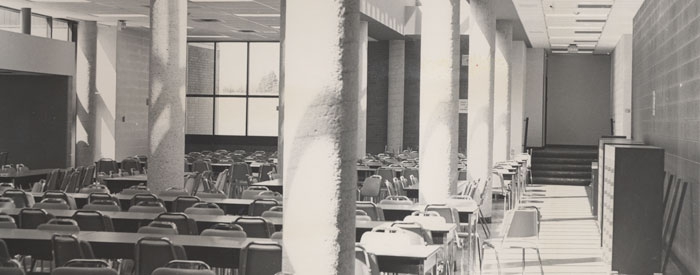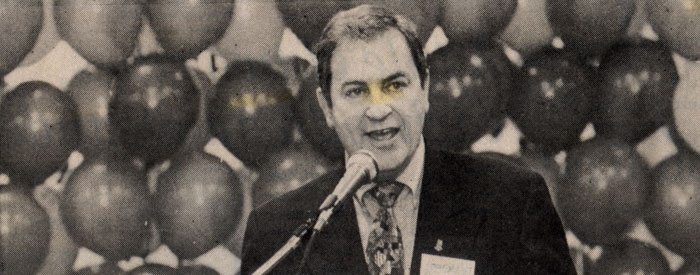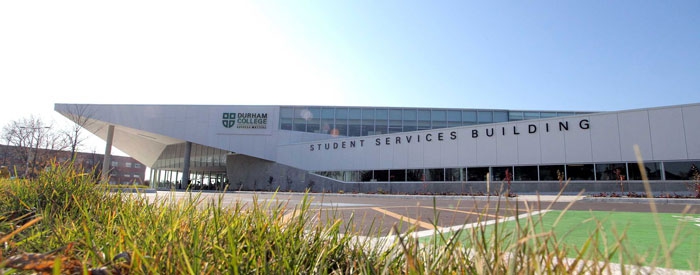An unwavering commitment to student success, high-quality programs led by exceptional professors with real-world experience, graduates who’ve gone on to outstanding career success and a treasured relationship with the community – Durham College (DC) has been guided by these ideals since 1967.
1965 TO 1969

Aerial view of the college before being named the Gordon Willey building.
In May 1965, former Ontario Education Minister Bill Davis introduced legislation to establish colleges of applied arts and technology across the province. The legislation reflected a profound new approach to education that has energized, stimulated and transformed the provincial and national economies ever since.
Community leaders in the region quickly responded to this announcement and on October 13, 1966, a volunteer board of governors for Durham College (DC) met for the first time. Administrative offices were soon set up in The Bateman House at 304 Simcoe Street North, a location that was provided by the Oshawa General Hospital. Before long, a permanent campus for the college was found when E.P. Taylor came forward and identified the southwest corner of Conlin and Simcoe streets as a suitable home.
DC officially opened for studies on September 18, 1967, in 16 portable classrooms, employing a staff of 14 and serving 205 students. The first academic calendar offered courses in applied arts, business and technology. The college’s first president, Dr. Gordon Willey, affectionately known as Doc, was an engineer by trade and placed special emphasis on technology.
1970 TO 1979

The cafeteria, which sat 400 students and served warm meals day and night, opened in September 1971.
The college flourished from the start, soon opening two permanent buildings in 1970 and 1971, expanding programs and celebrating enrolment growth. By its 10th anniversary, courses were also being offered in health sciences and adult training, while enrolment had climbed to more than 1,250 students.
Of note, the campus was home to the Regional Municipality of Durham’s first office. Durham Region officially came into being January 1, 1974, comprised of eight municipalities, including Oshawa, Whitby, Ajax and Pickering.
1980 TO 1989

Ruth Milne at a ribbon cutting ceremony.
The 1980s were marked by change and growth for the college. Dr. Willey was succeeded by Mel Garland and further expansion of facilities continued with a focus on bringing the latest technology to the classroom. This included the construction of a new state-of-the-art Robotics lab, the precursor to the Integrated Manufacturing Centre found on campus today.
By the college’s 20th anniversary in 1987, enrolment was close to 2,700 full-time students and in 1988, Dr. Gary Polonsky was named president.
1990 TO 1999

President Gary Polonsky giving a speech.
Under President Polonsky’s leadership, the early 1990s brought more growth to the college, including the purchase of the Cadbury chocolate factory overlooking Highway 401 to establish its Whitby campus.
DC’s Whitby campus opened its doors in 1993; the centerpiece of the campus at the time was the Skills Training Centre, offering skilled trades and apprenticeship training.
2000 TO 2009

Aerial view of Oshawa campus.
Over the years, DC strived to offer students increased opportunities to unique educational pathways. Strong partnerships existed with York and Trent universities for years, eventually leading to the establishment of the Durham University Centre in 1996, which enabled Durham Region residents to take university courses here at home.
In 2003, the University of Ontario Institute of Technology (UOIT) (later renamed Ontario Tech University) opened its doors at the college’s Oshawa campus. With the addition of UOIT as a campus educational partner, DC students had an even richer campus experience. With access to new academic options, such as unique bridging programs, students in particular areas of study could move from college to university in pursuit of their educational and career goals.
September 2007 marked DC’s 40th anniversary. A year of celebrations kicked off with the City of Oshawa proclaiming September 18 as Durham College Day, while the unveiling of an Alumni Wall of Distinction in the Gordon Willey building in October and Homecoming weekend in May also marked four decades of post-secondary excellence.
On May 16, 2008, Don Lovisa was named interim president of DC and was formally appointed president on January 1, 2009.
The college’s enrolment grew to more than 7,100 students in full-time studies, thousands more in part-time studies and 1,400 apprentices. At this time, DC offered more than 100 full-time programs in high-demand areas.
On December 8, 2009, the college celebrated the grand opening of Phase 1 of the Whitby campus expansion. The initial phase of the expansion project included a second-storey addition that houses new classrooms and labs; the Incubation Centre, developed in partnership with the Durham Strategic Energy Alliance; and living lab environments in areas including solar water heating, solar cell systems, wind turbines and geothermal technology systems.
2010 TO 2019

Student Services building.
The Oshawa campus officially opened the Student Services building (SSB) in March 2011, offering one of the most comprehensive and all-encompassing service facilities in the province. The one-stop shop facility creates a vital first point of access for potential applicants, current students and graduates.
In May 2011, DC officially opened Phase 2 of the three-phase Whitby campus expansion. Phase 2 introduced an expanded shop focused on green-building trades and technology, as a follow up to the living labs introduced with Phase 1.
In September 2013, Phase 3 of the Whitby campus expansion, the Centre for Food (CFF), opened. Accommodating approximately 900 additional students studying a variety of programs in culinary, horticulture, hospitality and tourism fields.
DC’s new restaurant, Bistro ’67, a full-service, green-certified restaurant, officially opened in October 2013 at the Whitby campus. In addition to serving the public, the restaurant also provides a supportive and creative teaching environment with hands-on learning experience. The restaurant name pays homage to the year the college first opened its doors in 1967.
In April 2016, DC received $22 million in funding from the provincial government toward construction of the Centre for Collaborative Education (CFCE). The new three-storey building replaced the aging Simcoe building, which was originally built as a temporary structure, and brings together local, Indigenous and global communities. The CFCE opened in September 2017, offering a range of innovative learning spaces, including FastStartDC, The First Peoples Indigenous Centre and the Rotary Global Classroom, designed to support the diverse needs of students and the broader community.
2020 TO NOW

The Ontario Power Generation Centre for Skilled Trades and Technology (CSTT) building.
In 2020, Phase 4 of the Whitby campus expansion kicked off with the construction beginning on the Ontario Power Generation Centre for Skilled Trades and Technology (CSTT). Completed in 2022, the CSTT is a 60,000 sq. ft. building designed to support industrial skilled trades training, innovation and education.
Home to DC’s electrical, elevating devices and plumbing programs, students can innovate and learn in its many labs, configurable classrooms and a double-height learning space which is home to a two-storey building model. In addition, the CSTT features student collaboration areas, food service facilities and a 2,000 sq. ft. Fitness Centre.
In April 2023, the construction of our new Centre for Innovation and Research (CIR) was finished. Located in the former J Block at Oshawa campus, the CIR serves as a collaborative, state-of-the-art space that fosters creative thinking, networking, and partnerships between DC and our community.
The CIR houses the college’s Office of Research Services, Innovation and Entrepreneurship (ORSIE), as well as four of six applied research centers: the AI Hub, Centre for Cybersecurity Innovation, Mixed Reality Capture Studio, and the Social Impact Hub. Additionally, it is home to the Institutional Research Team and the Experiential Learning Hub.
In August 2023, DC celebrated the grand opening of two new modern and collaborative learning spaces: PROTO and an Electric Vehicle (EV) Lab. These new state-of-the-art spaces, located inside DC’s Whitby campus’ main building, span 9,060 sq. ft. PROTO offers clients, industry partners, student engineers, skilled trades faculty members, and students an opportunity to collaborate and develop creative solutions and prototypes to address industry challenges.
The EV Lab, which makes DC one of only a few Ontario colleges with a dedicated EV learning space, equips students with the specialized skills required in the evolving automotive industry.
In 2023, after 15 years, Don Lovisa announced he would not renew his contract as President. His vision and leadership left a lasting impact on the college and the community and to honour him, the main building of the Whitby campus was renamed the Don Lovisa Building.
In March 2024, Dr. Elaine Popp took the reign as the new President of Durham College, succeeding President Don Lovisa. With over 24 years of experience in Ontario’s education sector, Dr. Popp has demonstrated a strong commitment to student success and industry partnerships during her time as DC’s Executive Vice President, Academic, for eight years. She has been instrumental in launching new academic programs, expanding work-integrated learning opportunities, and establishing research centers. Her vision for the future of DC emphasizes sustainability, equity and community engagement.
